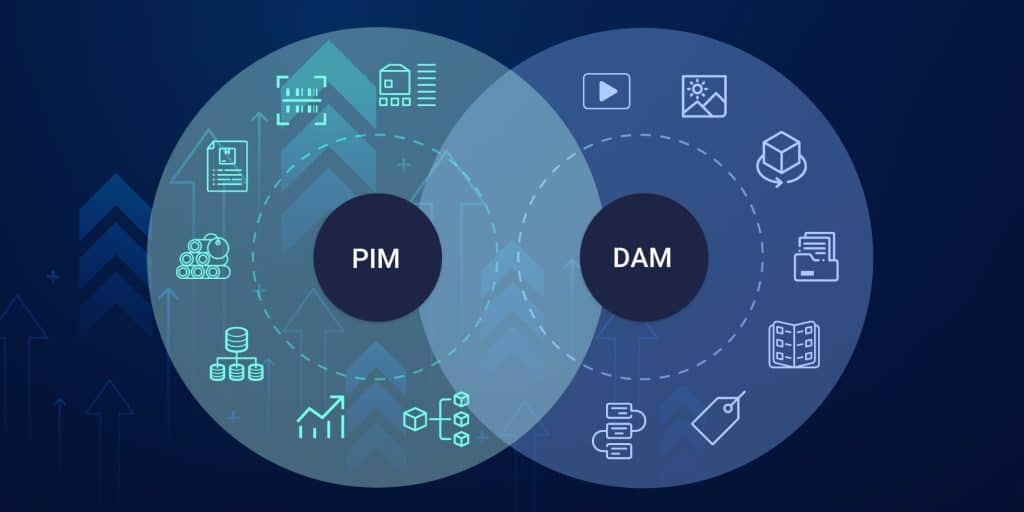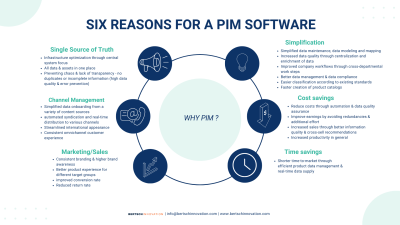Blog
PIM & DAM: Differences and their
successful combination

From websites and online stores to marketplaces, apps and social media channels – there are many channels available for product marketing these days. Modern consumer behavior requires the continuous use of all available channels to ensure retail success.
However, the concept of omnichannel marketing is not that easy to achieve. Each channel has its own user and target groups and places different demands on the content presented. This creates an enormous amount of work for anyone selling products or services.
A PIM and DAM system is able to assist marketing teams by making their day-to-day work much more efficient.
But what are these tools all about? What are the differences? What do they have in common? And why do they offer unbeatable added value when used in combination?
PIM – Product Information Management
What is a PIM system?
Product information management systems focus primarily on the product as such. It is about pure product information, such as product descriptions, technical data or prices of the respective products. PIM systems are more descriptive in character and ensure that product data is available on every channel in a standardized and up-to-date form. PIM systems are essentially digital collection and distribution centers for product information. They map everything that is needed for product marketing and channel maintenance: The corresponding data model determines how the products are linked to information. They are able to manage channel-dependent representations and play out product content in a targeted and automated process using channel management. This makes a PIM software very valuable and efficient marketing tools.
A PIM quickly becomes indispensable for companies with a large or very complex product range. But a PIM system is also the ideal foundation for companies with heterogeneous target groups and international target markets. This is because multilingualism and different dimensions, standards and legal regulations play a role here, for example.
A PIM software offers a number of advantages:
You can find more reasons for using PIM software in the following download:
In fact, a PIM is already an absolute must-have for companies with a lower level of complexity in product communication. The general increase in productivity and process efficiency is clearly visible even with a smaller product range and ensures a significant increase in profits thanks to optimized processes.
In order to offer the best possible customer experience across every channel, a broad selection of digital content is required – from images and videos to documents and graphic elements.
Creative and organizational processes for media content do not fall within the core competence of a PIM system, but instead within the remit of a digital asset management system.
DAM – Digital Asset Management
What is a DAM-System?
A digital asset management system is a software solution that allows companies to manage digital content efficiently. This content includes all types of media such as images, videos or audio files, but also other creative content such as logos, graphics or design drafts. This includes information and media attributes such as keywords, descriptions and relationships to other objects. A DAM software also offers the corresponding search function, as well as a versioned storage function that is media-neutral and works with predefined standards. Stored digital assets can be found quickly and used in a targeted manner. The management of digital assets without a DAM software is a complex and multi-layered task that can become a challenge even with a relatively small collection of data records.
In order to optimally support creative processes, which usually involve many different stakeholders, a DAM system also places functional emphasis on areas such as workflow management and role based access control. In addition, DAM systems are also equipped with interfaces so that they can be seamlessly integrated with creative applications such as Adobe Photoshop, Illustrator and other product and communication-related systems such as PIM.
A DAM software offer a number of advantages:
In addition to the management aspect, a DAM system offers options and functions for distributing digital assets to the relevant corporate and sales channels.
The product experience is an essential pillar of marketing and requires a solid structure – PIM and DAM systems offer exactly that.
The use of visual elements alongside written elements is an essential tool for corporate communication. After all, customers and prospects are addressed in a different way by visual elements than by purely written components of marketing.
The challenge of product content management
In product content management, i.e. the management, maintenance and distribution of product content, many components come together.
It requires:
- A combination of product data and media content to create informative and appealing product content.
- content to be simultaneously and precisely directed to the individual sales and marketing channels
- Product content to be prepared for specific target groups and, ideally, personalized to provide additional incentives for the purchase decision at the touchpoint.
Product communication therefore becomes a challenge. This applies particularly in the case of multiple channels and target groups, such as international product marketing.
Product content management is a highly complex process chain that requires well thought-out and efficient organization and management of the individual steps for a smooth process. As the complexity or number of products and channels increases, the support of various software solutions is also a prerequisite. This is the only way to limit the associated costs and keep the time-to-market short while maintaining high quality.
Consequently, PIM & DAM are an important source of support.
PIM and DAM combined: Product Content Management
Maximizing efficiency and productivity is achieved by combining both systems - like mediacockpit from Bertsch Innovation. The digital assets managed within the DAM rely on the product data provided by the PIM. This enables you to significantly increase your own performance in terms of availability and accuracy.
The following download gives you an overview of all the features and benefits of mediacockpit:
Today, the success of manufacturing and trade companies depends on PIM and DAM or the linking of both systems. Media content is made available flexibly and efficiently. The basic structure of PIM and DAM systems allows for scalability.
Both systems have the mutual goal of being able to provide product content in the best possible organized, qualified and integrated manner. Thanks to their complementary structure, PIM and DAM systems offer the ideal foundation and every company can benefit from this synergy accordingly.
Each subsystem focuses on its own strengths and areas of responsibility, but together they complement each other perfectly. Especially systems that offer a combination of both individual system worlds, such as mediacockpit from Bertsch Innovation, enable resource-efficient work. All functions of both DAM and PIM systems are combined in a single user interface. This allows users to handle product content in an ideal way, which, once processed by the respective systems, can then be transferred to the company's target channels. These include online stores, social media channels, websites, but also offline media such as catalogs or other print formats.
Successful product and brand communication therefore always requires both: media content and editorially prepared texts.
This is why Bertsch Innovation offers an all-inclusive product content management solution that closely interlinks the PIM and DAM disciplines and combines them in a standardized user interface.
Highlighted Whitepaper
Manifest: One-Stop Product Content Experience
Grâce à une expérience de contenu produit One-stop, nous aidons nos clients à façonner leur avenir individuel sur le marché de manière durable et sécurisée.
Accomplir plus ensemble
Nous croyons en la valeur de la collaboration et de l’échange. Cela s’applique aussi bien à nos projets clients, desquels nous tirons de nombreuses informations précieuses pour le développement de nos produits, et à notre réseau de partenaires en pleine expansion, avec lequel nous soutenons nos clients dans leur numérisation.





